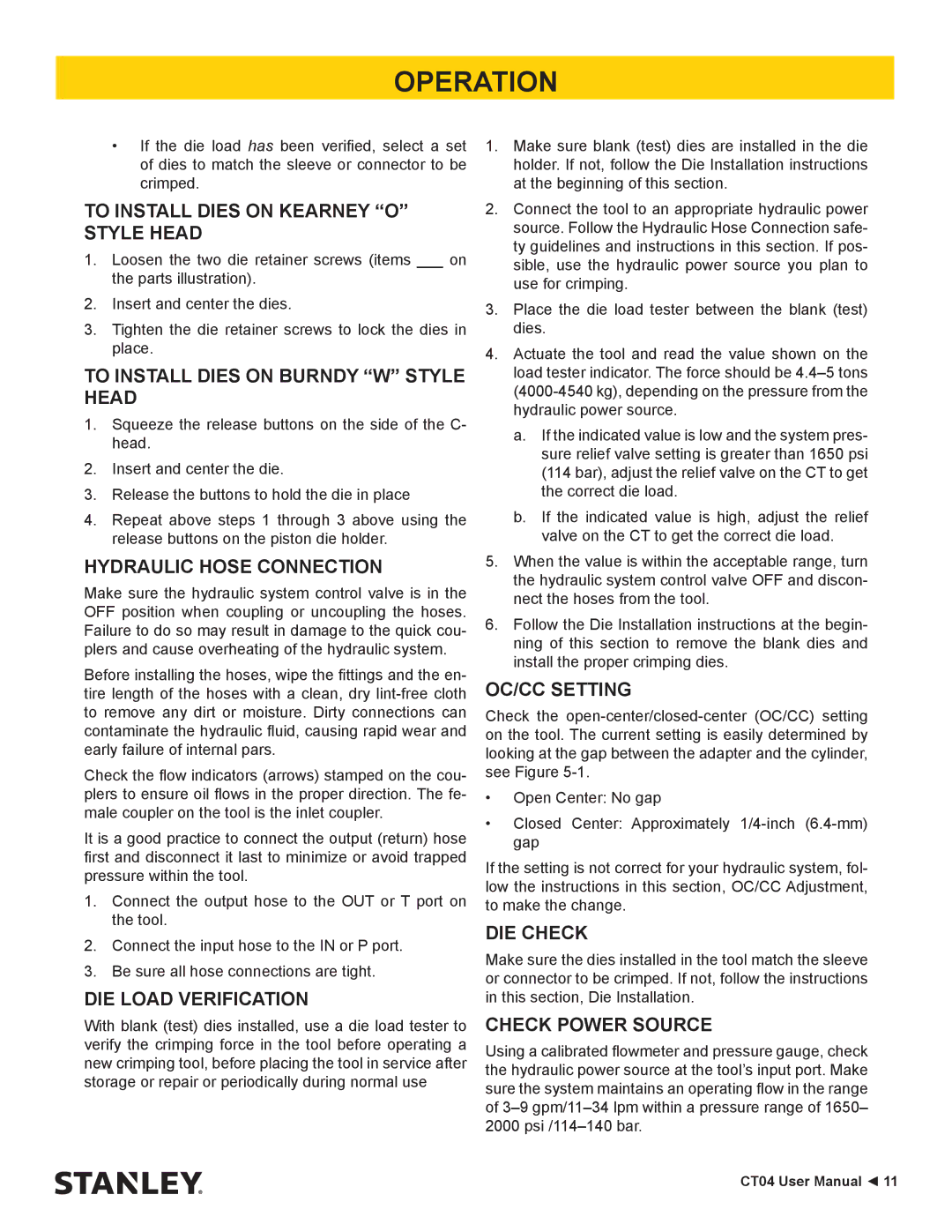
OPERATION
•If the die load has been verified, select a set of dies to match the sleeve or connector to be crimped.
TO INSTALL DIES ON KEARNEY “O” STYLE HEAD
1.Loosen the two die retainer screws (items ___ on the parts illustration).
2.Insert and center the dies.
3.Tighten the die retainer screws to lock the dies in place.
TO INSTALL DIES ON BURNDY “W” STYLE HEAD
1.Squeeze the release buttons on the side of the C- head.
2.Insert and center the die.
3.Release the buttons to hold the die in place
4.Repeat above steps 1 through 3 above using the release buttons on the piston die holder.
HYDRAULIC HOSE CONNECTION
Make sure the hydraulic system control valve is in the OFF position when coupling or uncoupling the hoses. Failure to do so may result in damage to the quick cou- plers and cause overheating of the hydraulic system.
Before installing the hoses, wipe the fittings and the en- tire length of the hoses with a clean, dry
Check the flow indicators (arrows) stamped on the cou- plers to ensure oil flows in the proper direction. The fe- male coupler on the tool is the inlet coupler.
It is a good practice to connect the output (return) hose first and disconnect it last to minimize or avoid trapped pressure within the tool.
1.Connect the output hose to the OUT or T port on the tool.
2.Connect the input hose to the IN or P port.
3.Be sure all hose connections are tight.
DIE LOAD VERIFICATION
With blank (test) dies installed, use a die load tester to verify the crimping force in the tool before operating a new crimping tool, before placing the tool in service after storage or repair or periodically during normal use
1.Make sure blank (test) dies are installed in the die holder. If not, follow the Die Installation instructions at the beginning of this section.
2.Connect the tool to an appropriate hydraulic power source. Follow the Hydraulic Hose Connection safe- ty guidelines and instructions in this section. If pos- sible, use the hydraulic power source you plan to use for crimping.
3.Place the die load tester between the blank (test) dies.
4.Actuate the tool and read the value shown on the load tester indicator. The force should be
a.If the indicated value is low and the system pres- sure relief valve setting is greater than 1650 psi
(114 bar), adjust the relief valve on the CT to get the correct die load.
b.If the indicated value is high, adjust the relief valve on the CT to get the correct die load.
5.When the value is within the acceptable range, turn the hydraulic system control valve OFF and discon- nect the hoses from the tool.
6.Follow the Die Installation instructions at the begin- ning of this section to remove the blank dies and install the proper crimping dies.
OC/CC SETTING
Check the
•Open Center: No gap
•Closed Center: Approximately
If the setting is not correct for your hydraulic system, fol- low the instructions in this section, OC/CC Adjustment, to make the change.
DIE CHECK
Make sure the dies installed in the tool match the sleeve or connector to be crimped. If not, follow the instructions in this section, Die Installation.
CHECK POWER SOURCE
Using a calibrated flowmeter and pressure gauge, check the hydraulic power source at the tool’s input port. Make sure the system maintains an operating flow in the range of
CT04 User Manual ◄ 11
